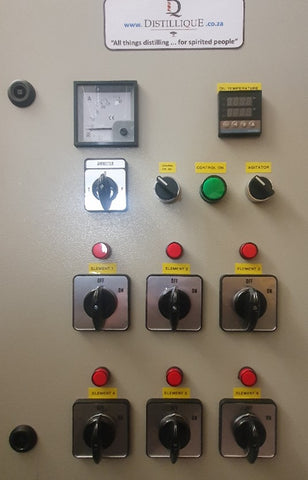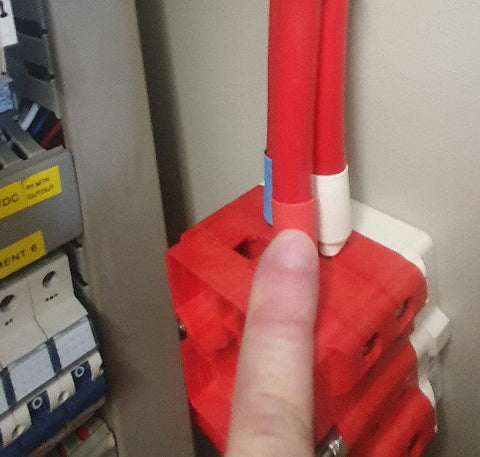Simple Electrical control boxes - or are they simple?
Gert BosmanIt really is simple. Or perhaps not? To switch a few electrical elements for stills on and off is as simple as inserting a switch in the electric supply and you’re done. … or perhaps not!
To design and build electrical control boxes that complies to SANS (South Africa National Standards) requires highly specialized skills and you must be certified as a master electrician to provide CoCs (Certificate of Conformances) after installation thereof.
Have a look at this electrical control box for a still boiler with oil filled heating jacket, six heating elements and an agitator that need switching. All using three-phase 380V power supply for a total of 72kW power. This will bring a 1600L mash to the boil within 2 hours.

The front panel (from top left to right) shows an ammeter and a digital programmable temperature display.
The ammeter shows the total amperage drawn by the heating elements and is used to quickly identify when a heating element has blown and not heating anymore. Then, together with the individual switches, it is simple to identify the specific heating element which needs to be replaced.
The digital programmable temperature display allows the setting of the maximum temperature of the heating jacket oil. The oil should never be heated above the oil’s smoking (or cracking) temperature. Once the oil temperature reaches the programmed temperature, it will switch the heating elements off and back on again when the heating oil temperature falls below the pre-programmed setting.
Below the Ammeter is a phase selector switch. This allows you to view the amperage of each phase to be shown separately. Most 3-phase heating elements has a separate heating loop per phase. This switch allows you to also see if only one, or two, or perhaps all three loops of an element is not working anymore.
Then to the right of the phase selector switch is a switch to switch the automated control on or off. This allows to override the switching based on oil temperature. A green pilot light next to the auto control switch shows when the auto control is on or off. Next to the green pilot light is finally an agitator switch in this row of controls. With the agitator switch on, the agitator in the boiler will ensure that there is a fairly even spread in mash temperature while bringing the mash to a boil. Once the mash is boiling, the agitator can be switched off.
The bottom two rows of this specific control box contains 6 switches and red pilot lights to switch individual elements on and off as and when required. With start of each distilling batch, all six elements will be switched on to bring the oil as quickly up to it’s set temperature to ensure the fastest “bring-to-boil” time (This would be the normal practice. For other scenarios you would also switch off selected heating elements when bringing the mash to a boil). Once the mash is boiling, different elements can be switched of to reduce the electricity demand during distillation whilst maintaining the required oil temperature.
Now let’s have a look at the inside of the control box. This is a little more complicated and involved that when looking at the front panel only.
This picture shows the rear of the control box. You may notice that the wires are relatively thin. This is because the switches are not switching the heavy loads of the heating elements but are just providing a signal to the contactors (heavy duty switches) to actually switch the heating element.
Of prime importance to Distillique are safe, neat and functional control boxes that should last many years or preferably many decades!
Let’s move to the inside of this control box:

Here we see a totally different picture. Gone are the simplistic front cover of the box.

Thick cables (capable of conducting many amperes), robust switching gear for each phase (three in total) of each element (six in total), a soft start for the agitator motor, voltage comparators (for protection on undervoltage and overvoltage situations – as experienced in Africa and more and more in South Africa as well)
Also is a full isolating switch (right hand side bottom of picture) to switch more than a 100 Ampere at 380V for each of the three phases. This literally means the isolating switch can switch more than 300A at 380V. This is more than required but increases the life expectancy of the switch to many, many years. The same principle is followed with the other components. Distillique build and supply excellent control boxes. Unfortunately they are more expensive than Chinese supplied control boxes but, from our own experience, will last decades rather than just months. The control boxes from Distillique complies to SANS (South African National Standards) requirements. These specifications are there to ensure your safety. Distillique also makes sure that the box will last many, many years but preferably for many decades of serious distilling!
Some close-up pictures on the inside:




Some other control boxes that we designed and manufactured:
Six fermentation tank temperature control:


Remote control (through Wi-Fi and or Bluetooth) monitoring and switching demo:

Electrical control boxes - not so simple for craft distilleries.
Have a look at some of our standard control boxes or contact us to design and build a custom control box specifically as you require.
